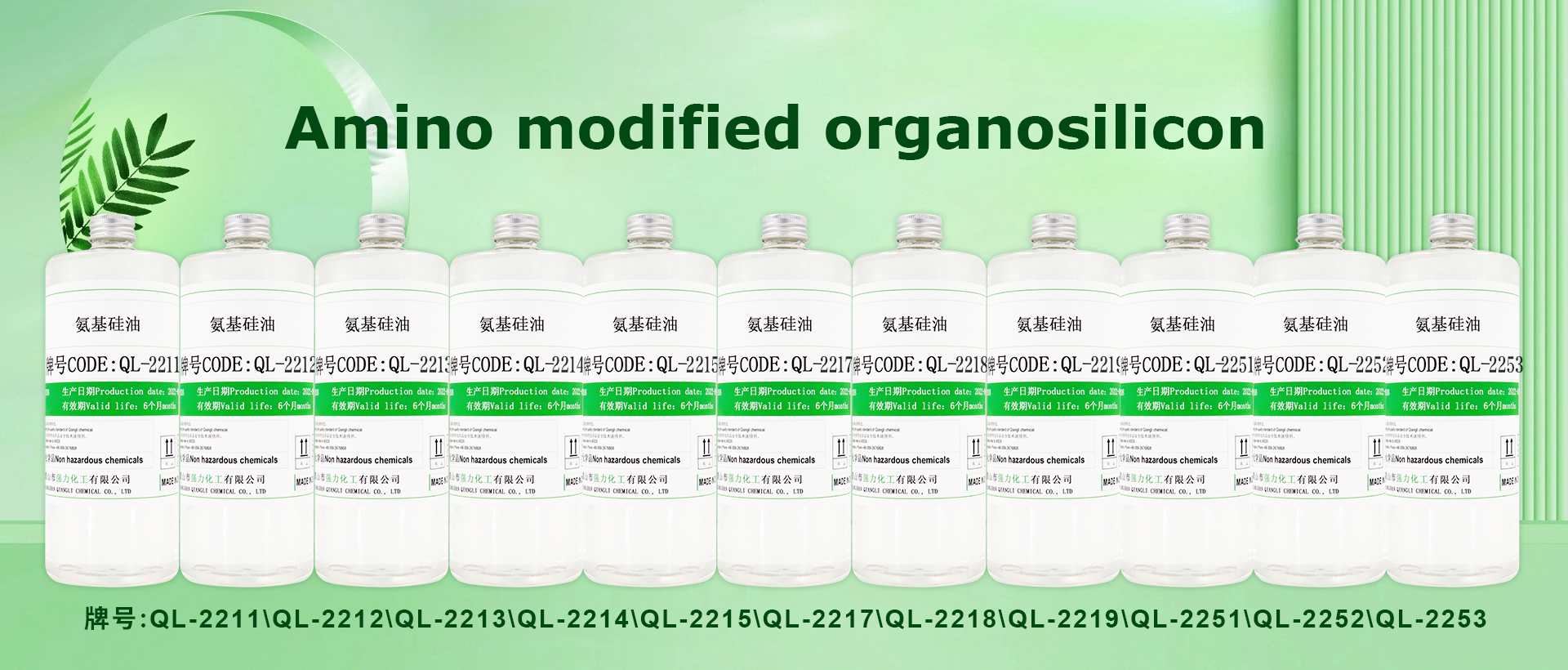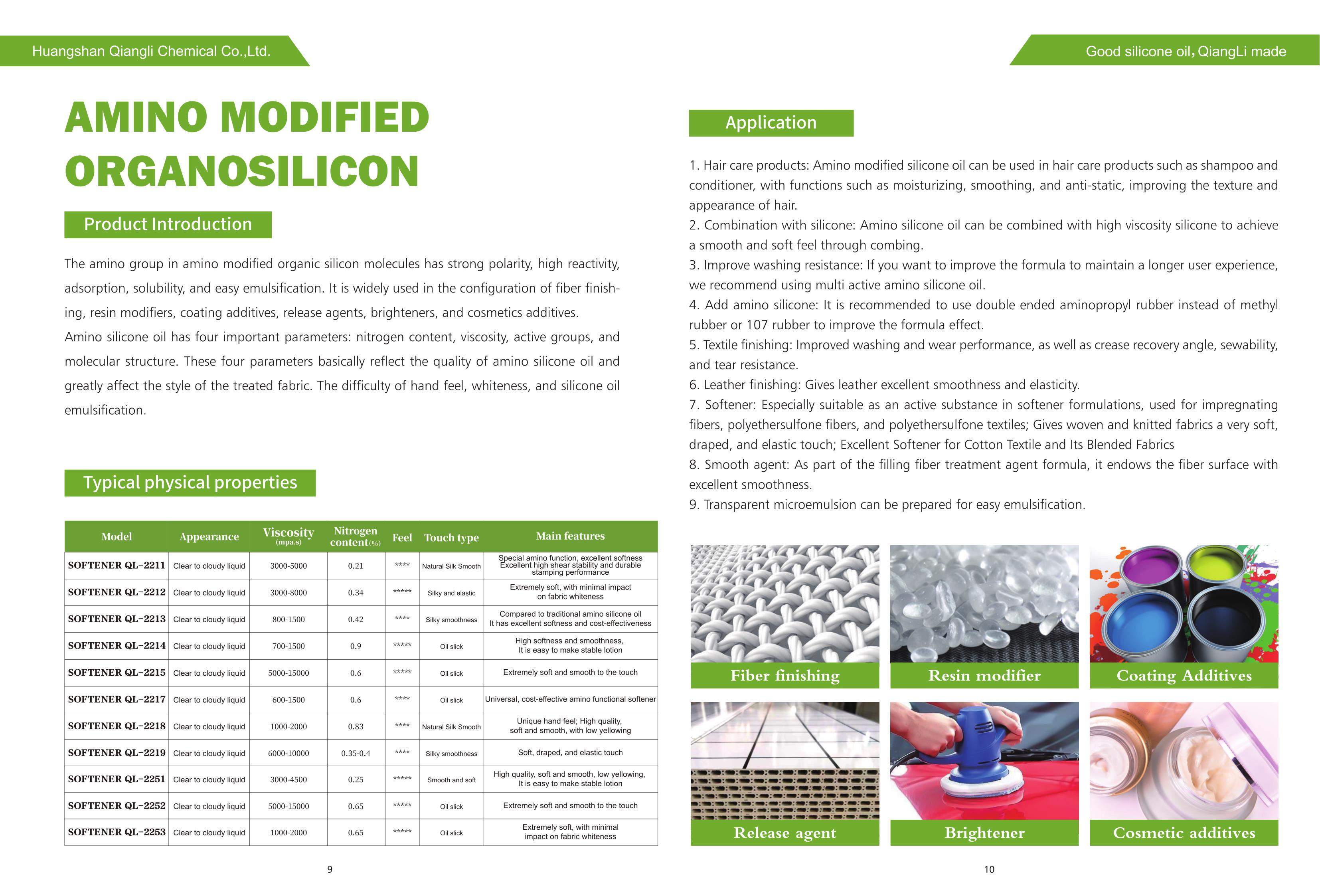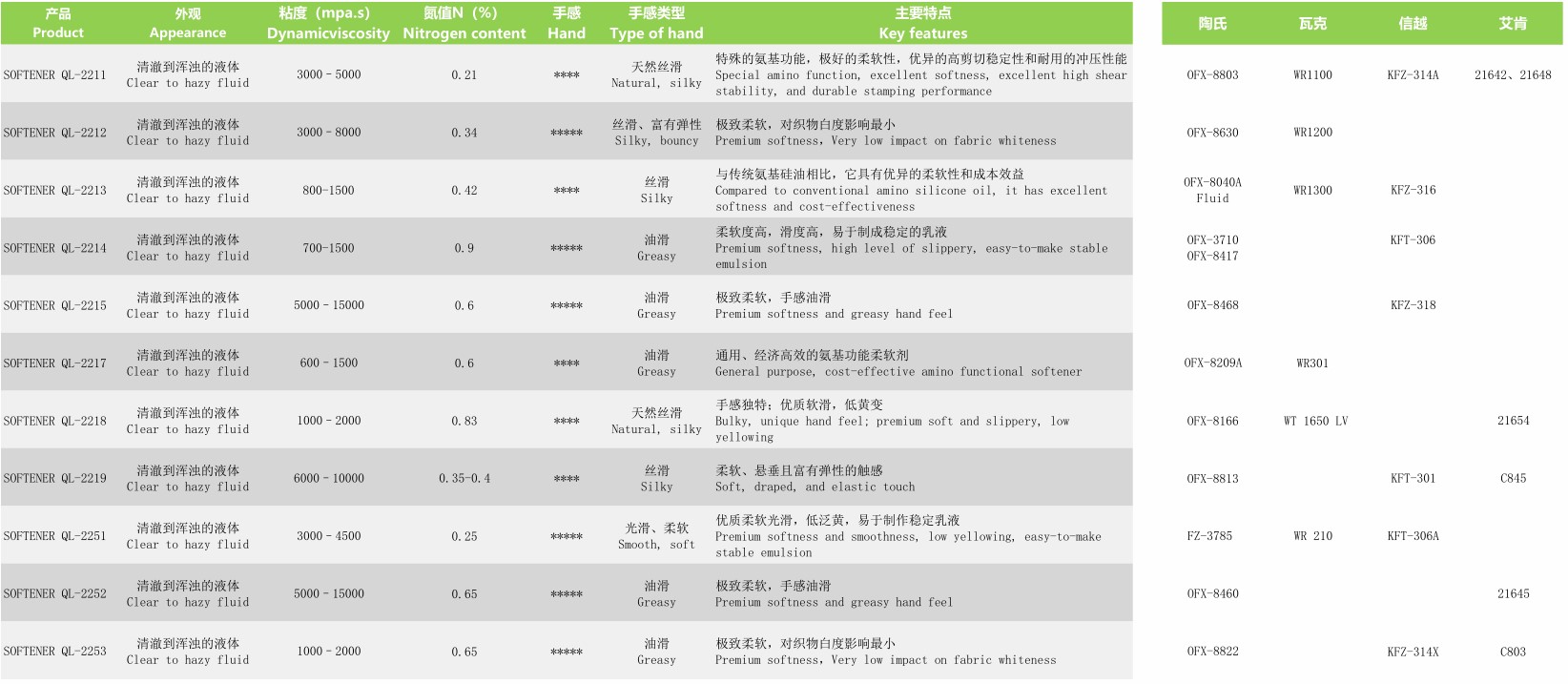Amino silicone oil is the basic ingredient specially used in textile softening agents. It has the best adsorption, compatibility and easy emulsification. Using a mixer or homogenizer, aminosilicone fluids are easily emulsified by appropriate surfactants into stable, transparent microemulsions. It can be used alone or combined with other silicone or organic softeners to form a special softening finishing agent, suitable for the softening finishing of various textiles.

The emulsion made by adding emulsifier to amino silicone oil is often used as fiber fabric treatment agent to significantly improve softness, wrinkle resistance, elasticity and tear resistance. It is also used as polishing agent for instruments and furniture, paper treatment agent, coating antifreeze and anti-rust and anti-corrosion agent for metal. In addition, amino silicone oil can also be used as a compounding agent in hair products such as hair oil and hair wax to make hair soft and shiny.
Regarding the selection of amino silicone oil, the editor believes that it can be explained from the following aspects.
1. Structure
Polysiloxane has an easily twisted spiral branched chain structure that can only rotate around the main chain, so the main chain is very flexible, which determines that polysiloxane can become an excellent softener for fabrics.
The high polarity of the amino groups in amino-modified polysiloxane allows it to interact with hydroxyl groups, carboxyl groups, cyano groups, ester groups, amide groups, etc. in the fibers to form strong adsorption and orientation, thereby reducing friction between fibers. coefficient, making it smooth and soft.
Mechanism of action of amino silicone oil: The structural characteristics of amino silicone oil can be characterized by three important parameters, namely ammonia value, viscosity and reactivity. It basically reflects the quality of amino silicone oil and affects the performance of treated fabrics.

 2. Ammonia value
2. Ammonia value
The various properties that amino silicone oil imparts to fabrics are brought about by the amino groups in the polymer.
The amino content can be represented by amino groups. The higher the amino content, the higher the ammonia value, and the softer and smoother the finished fabric will be. This is because the increase in amino functional groups increases the affinity to the fabric, thus giving the fabric a soft and smooth feel.
However, the active hydrogen in the amino group is easily oxidized to form a chromophore, causing the fabric to become yellowish or slightly yellowish. In the case of the same amino group, it is obvious that as the amino group content (or ammonia value) increases, the probability of oxidation increases and the yellowing phenomenon becomes serious.
Of course, if the degree of oxidation of active hydrogen in the amino group is reduced, the yellowing phenomenon can be reduced. For this reason, there are various amino modification products, such as secondary amino modification, tertiary amino modification, etc.
At the same time, it also affects other properties, such as feel, whiteness, water absorption, easy decontamination, etc. The feel of conventional amino silicone oil is slightly inferior to that of tertiary ammonia-modified amino silicone oil due to primary ammonia and secondary ammonia, but in whiteness It has great disadvantages in terms of strength, water absorption and easy decontamination performance.
As the ammonia value increases, the polarity of the amino silicone oil molecules increases, which provides favorable prerequisites for the emulsification of the amino silicone oil and can be made into a microemulsion. The choice of emulsifier is related to the size and distribution of particle size in the emulsion and the ammonia value.
3. Viscosity
Viscosity is related to polymer molecular weight and molecular weight distribution.
The greater the viscosity, the greater the molecular weight of the amino silicone oil, the better the film-forming property on the fabric surface, the softer the hand feeling, and the better the smoothness; however, due to the excessive molecular weight, its permeability will become very poor, especially for strong fabrics. For tightly twisted fabrics and strongly twisted fine-denier fabrics, it is difficult for amino silicone oil to penetrate into the fiber and affect the performance of the fabric.
If the viscosity is too high, it will be more difficult to prepare stable microemulsions. When adjusting a product, you generally cannot just increase or decrease the ammonia value to adjust the feel. You need to change the ammonia value and viscosity together.
Usually the ammonia value is low and the viscosity must be high to balance the softness of the fabric. Smooth feel requires high viscosity amino-modified silicone oil.
During soft finishing and baking, some amino silicone oil is cross-linked to form a film, thereby increasing the molecular weight. Therefore, the initial molecular weight of the amino silicone oil is different from the molecular weight of the amino silicone oil forming a film on the final fabric.
Therefore, the same amino silicone oil is processed under different process conditions. The smoothness of the final product can vary significantly.
On the other hand, low-viscosity amino silicone oil can also improve the feel of the fabric by adding cross-linking agents or adjusting the baking temperature.
Low viscosity amino silicone oil has good permeability, and through cross-linking agent and process optimization, the advantages of high and low viscosity amino silicone oil can be combined.
The molecular weight distribution of amino silicone oil may have a greater impact on product performance.
After the fabric is finished, the low molecular weight amino silicone oil penetrates into the interior of the fiber, while the high molecular weight is distributed on the outer surface of the fiber, so that both the inside and outside of the fiber are wrapped by the amino silicone oil, giving the fabric a plump, soft and smooth feel, but it may cause problems. The molecular weight difference is too large, which affects the stability of the microemulsion and the selection of emulsification conditions.

4. Reactivity
Reactive amino silicone oil has cross-linking properties during processing, which increases the degree of cross-linking and helps to increase the smoothness, softness and fullness of the fabric, especially the improvement of elasticity.
If hydroxyl groups are introduced into the side chain, performance in this area can be improved. If the side chain of the molecule does not contain hydroxyl groups, and the end group is hydroxyl, it can also increase adsorption when used on wool fibers; if the end group is methyl, it can be used on cotton fabrics; if the end group is methoxy, it can be used on synthetic fiber fabrics. .
5. PH value
Generally, the pH value of amino silicone oil microemulsion is controlled at around 4 to 6. At this time, repulsive force is generated between the emulsion particles to prevent particle aggregation, which is conducive to the formation of microemulsion.
When nonionic surfactants are used as emulsifiers, acid is usually added to form an emulsion. However, the addition of acid to the microemulsion will affect the ionicity of the microemulsion.
When the pH value is 7, the emulsion is non-ionic; when the pH value is <7, it is cationic. The smaller the pH value, the stronger the cationic charge, which increases the adsorption of fibers. However, acids and amino silicone oil form quaternary ammonium salts. This quaternary ammonium salt is easily affected by alkaline substances or electrolytes and hard water during processing, thus affecting the stability of the microemulsion and leading to phenomena such as oil drift and roller sticking.



